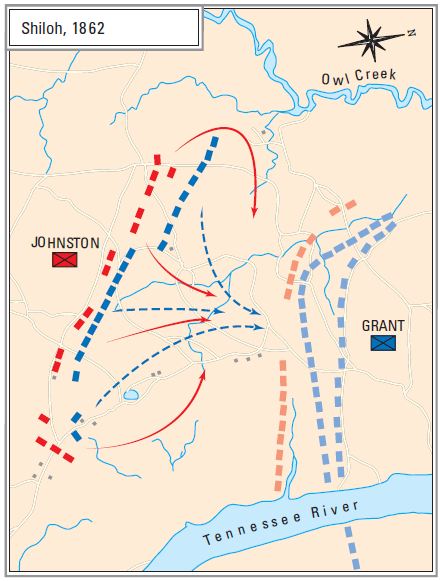Editor: Michael Spilling and Consultant Editor: Chris McNab
Just 2km south-west of Pittsburg Landing was Shiloh Church, the feature that would give the upcoming battle its common name. Stinging from Major General Ulysses Grant’s victories at Forts Henry and Donelson in February 1862, Gen Albert Sidney Johnston had withdrawn from Tennessee and concentrated his Confederate forces at Corinth, Mississippi.

Major General Ulysses Grant assembles his forces at Shiloh
Grant arranged his command in a largely administrative camp configuration while he waited for Buell to join him to conduct a combined attack on Corinth. Assembling some 45,000 men at Pittsburg Landing, Tennessee, about 32km northeast of Corinth, he waited for the arrival of Major General Don Carlos Buell’s Army of the Ohio from Nashville.
Grant never considered Johnston might launch his own offensive, and was caught by surprise when Johnston marched from Corinth and attacked before dawn on 6 April. The Confederates attacked with Major General William Hardee’s Third Army Corps and MGen Braxton Bragg’s Second Army Corps deployed in line, followed by Major General Leonidas Polk’s First Army Corps and then BGen John Breckinridge’s Reserve Corps advancing in column formation.
The Confederate attack hit the part of the Federal line occupied by BGen Benjamin Prentiss’s 6th Division, whose stubborn defense of the ‘Hornet’s Nest’ bought time for Grant to reorganize his force. When Johnston was killed leading an attack through a peach orchard just to the right of the Hornet’s Nest, Gen Pierre Gustave Toutant Beauregard assumed command and launched a series of frontal assaults that eventually forced the Federals to withdraw back to Pittsburg Landing.
Beauregard’s ‘Lost Opportunity’
Although initially caught off guard, Grant used Prentiss’ stubborn defense to organize the stragglers into units and form a new defensive line that ran inland at a right angle from the Tennessee River above Pittsburg Landing northwestwards towards Owl Creek. There he held on until reinforcements
from Buell’s 35,000-man army began arriving at 19:00. In spite of the early Confederate success, the tide of the battle was beginning to turn in favor of the Federals.
Still, Beauregard believed the Confederate attack had carried the day and stopped the pursuit, declaring ‘the victory is complete’. Beauregard was later subjected to much historical scrutiny for missing what became known as the ‘Lost Opportunity’ to destroy Grant’s army. For his part, Grant continued to receive reinforcements and resolved to counter-attack the next day.

Striking before dawn and taking advantage of the numerical advantage gained by the arrival of Buell, the Federals enjoyed quick success. Grant easily recaptured most of the ground he had earlier lost, and by 14:30 Beauregard decided to withdraw back towards Corinth. Grant’s men were too exhausted to effectively pursue.
The largest battle fought on American soil
The battle of Shiloh was the biggest battle fought in North America to that date. Of the 62,000 Federals engaged, 13,047 were killed, wounded or missing. The Confederates suffered 11,694 casualties from their 44,000- man army. The Confederate forces in the west were now committed to an unwinnable war of attrition.
Dr. Chris McNab is the editor of AMERICAN BATTLES & CAMPAIGNS: A Chronicle, from 1622-Present and is an experienced specialist in wilderness and urban survival techniques. He has published over 20 books including: How to Survive Anything, Anywhere — an encyclopedia of military and civilian survival techniques for all environments — Special Forces Endurance Techniques, First Aid Survival Manual, and The Handbook of Urban Survival. In his home country of Wales, UK, Chris provides instruction on wilderness hunting techniques and he is also an experienced martial arts instructor.
